NBN Project Analysis: A Case Study in Scheduling and Control
VerifiedAdded on 2023/06/12
|9
|1659
|339
Case Study
AI Summary
This case study examines the National Broadband Network (NBN) project in Australia, focusing on its scheduling and control challenges. It begins by evaluating the project's goal, identifying shortcomings in its definition, particularly the absence of a timeline. The analysis then delves into the root causes of the project's issues using a Current Reality Tree (CRT), pinpointing poor feasibility studies, budgeting, and inadequate risk and stakeholder management as key factors. The study further employs an Evaporating Cloud to illustrate the conflicts arising from political differences and a lack of consensus on project execution. Ultimately, the case study highlights the impact of these factors on the project's delays, budget overruns, and failure to meet objectives, emphasizing the critical role of effective project management and stakeholder collaboration. The document provides a goal tree, CRT and evaporating cloud as a part of the analysis.

Running head: PROJECT SCHEDULING AND CONTROL 1
Project Scheduling and Control
Name
Date
Project Scheduling and Control
Name
Date
Paraphrase This Document
Need a fresh take? Get an instant paraphrase of this document with our AI Paraphraser
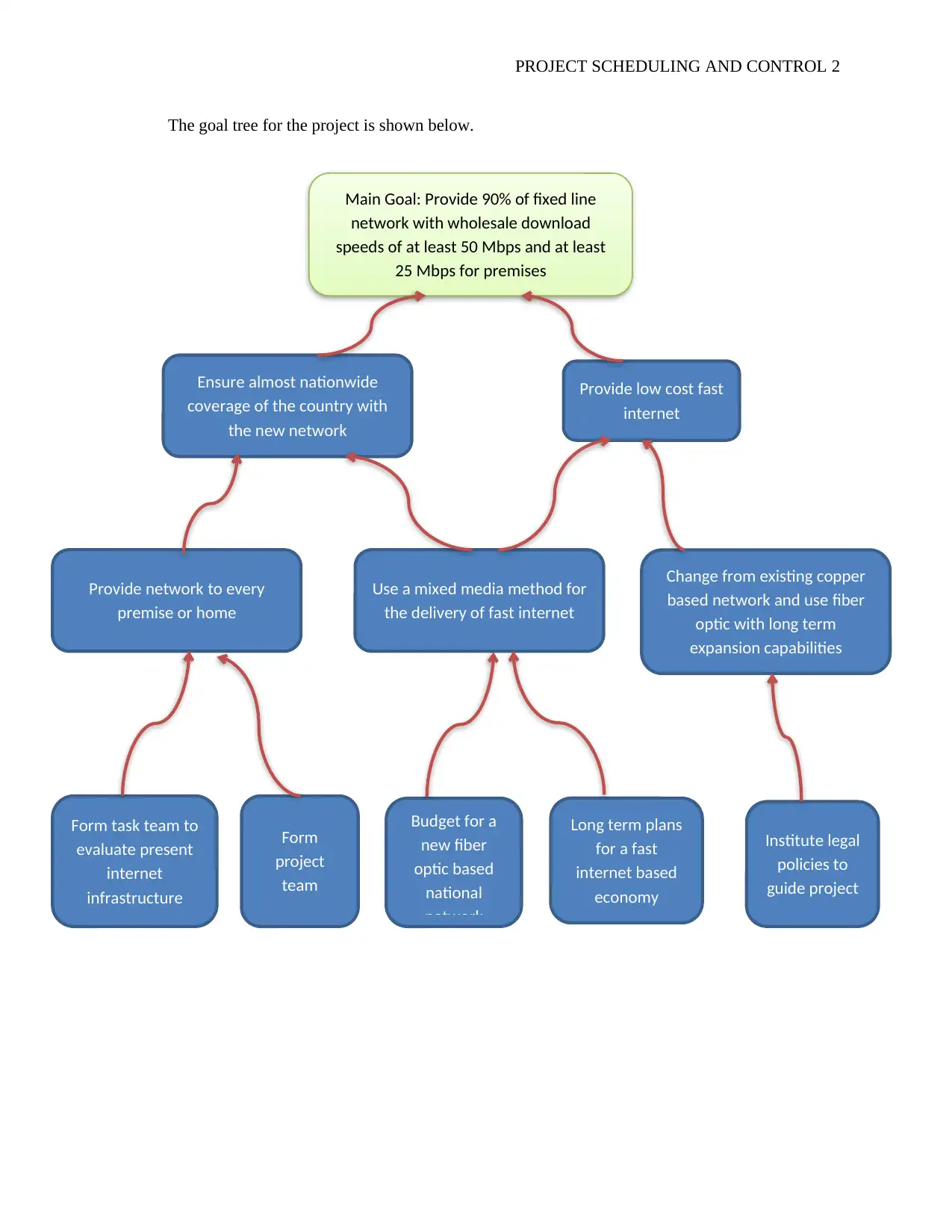
PROJECT SCHEDULING AND CONTROL 2
The goal tree for the project is shown below.
Main Goal: Provide 90% of fixed line
network with wholesale download
speeds of at least 50 Mbps and at least
25 Mbps for premises
Ensure almost nationwide
coverage of the country with
the new network
Provide network to every
premise or home
Change from existing copper
based network and use fiber
optic with long term
expansion capabilities
Provide low cost fast
internet
Use a mixed media method for
the delivery of fast internet
Long term plans
for a fast
internet based
economy
Budget for a
new fiber
optic based
national
network
Form
project
team
Form task team to
evaluate present
internet
infrastructure
Institute legal
policies to
guide project
The goal tree for the project is shown below.
Main Goal: Provide 90% of fixed line
network with wholesale download
speeds of at least 50 Mbps and at least
25 Mbps for premises
Ensure almost nationwide
coverage of the country with
the new network
Provide network to every
premise or home
Change from existing copper
based network and use fiber
optic with long term
expansion capabilities
Provide low cost fast
internet
Use a mixed media method for
the delivery of fast internet
Long term plans
for a fast
internet based
economy
Budget for a
new fiber
optic based
national
network
Form
project
team
Form task team to
evaluate present
internet
infrastructure
Institute legal
policies to
guide project

PROJECT SCHEDULING AND CONTROL 3
According to the nbn website, the goal of the project is well defined; according to the website, the
goal of the project is to provide at least 90% of the fixed line network with wholesale download speeds of
at least 50 Mbps while all premises will get at least 25 Mbps wholesale download speeds. However, the
goal is lacking one crucial component which is a timeline; a SMART goal should, as the acronyms mean,
be specific and measurable, as well as being relevant and time bound. The goal of the project fulfills the
first three requirements of being specific, measurable, and relevant; however, there is no specified time
period in which these could be achieved (O'Neill, 2009). According to Ochieng, Price & Moore (2017, p.
69), project goals should not only be specific and relevant, as well as measurable, they must be time
bound: this includes the project times also being time based, tangible and track-able so that the project
progress can be tracked based on a timeline. As such, an evaluation of the stated goal as per the nbn
website is that it is not very clear as would be required from a project management objective. Further, the
goal is defined with a minimum mandatory level and this is very clearly stated. Other bureaucratic
requirements are well defined in the statement, and so to grade the clarity of the goal, this paper grades it
at 3.5 out of 5.
According to the nbn website, the goal of the project is well defined; according to the website, the
goal of the project is to provide at least 90% of the fixed line network with wholesale download speeds of
at least 50 Mbps while all premises will get at least 25 Mbps wholesale download speeds. However, the
goal is lacking one crucial component which is a timeline; a SMART goal should, as the acronyms mean,
be specific and measurable, as well as being relevant and time bound. The goal of the project fulfills the
first three requirements of being specific, measurable, and relevant; however, there is no specified time
period in which these could be achieved (O'Neill, 2009). According to Ochieng, Price & Moore (2017, p.
69), project goals should not only be specific and relevant, as well as measurable, they must be time
bound: this includes the project times also being time based, tangible and track-able so that the project
progress can be tracked based on a timeline. As such, an evaluation of the stated goal as per the nbn
website is that it is not very clear as would be required from a project management objective. Further, the
goal is defined with a minimum mandatory level and this is very clearly stated. Other bureaucratic
requirements are well defined in the statement, and so to grade the clarity of the goal, this paper grades it
at 3.5 out of 5.
⊘ This is a preview!⊘
Do you want full access?
Subscribe today to unlock all pages.

Trusted by 1+ million students worldwide
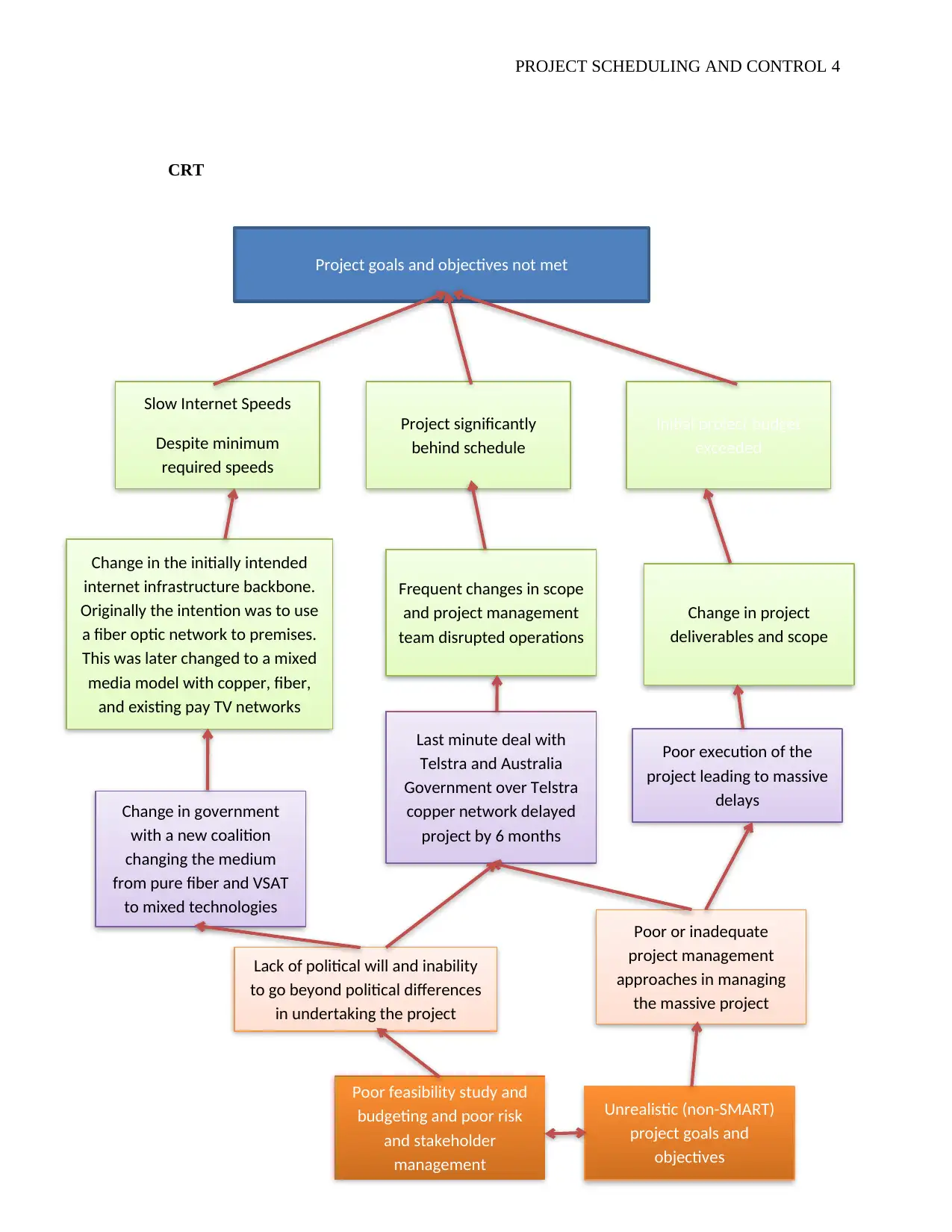
PROJECT SCHEDULING AND CONTROL 4
CRT
Slow Internet Speeds
Despite minimum
required speeds
Project significantly
behind schedule
Initial project budget
exceeded
Project goals and objectives not met
Change in the initially intended
internet infrastructure backbone.
Originally the intention was to use
a fiber optic network to premises.
This was later changed to a mixed
media model with copper, fiber,
and existing pay TV networks
Change in government
with a new coalition
changing the medium
from pure fiber and VSAT
to mixed technologies
Frequent changes in scope
and project management
team disrupted operations
Change in project
deliverables and scope
Last minute deal with
Telstra and Australia
Government over Telstra
copper network delayed
project by 6 months
Lack of political will and inability
to go beyond political differences
in undertaking the project
Poor or inadequate
project management
approaches in managing
the massive project
Poor feasibility study and
budgeting and poor risk
and stakeholder
management
Poor execution of the
project leading to massive
delays
Unrealistic (non-SMART)
project goals and
objectives
CRT
Slow Internet Speeds
Despite minimum
required speeds
Project significantly
behind schedule
Initial project budget
exceeded
Project goals and objectives not met
Change in the initially intended
internet infrastructure backbone.
Originally the intention was to use
a fiber optic network to premises.
This was later changed to a mixed
media model with copper, fiber,
and existing pay TV networks
Change in government
with a new coalition
changing the medium
from pure fiber and VSAT
to mixed technologies
Frequent changes in scope
and project management
team disrupted operations
Change in project
deliverables and scope
Last minute deal with
Telstra and Australia
Government over Telstra
copper network delayed
project by 6 months
Lack of political will and inability
to go beyond political differences
in undertaking the project
Poor or inadequate
project management
approaches in managing
the massive project
Poor feasibility study and
budgeting and poor risk
and stakeholder
management
Poor execution of the
project leading to massive
delays
Unrealistic (non-SMART)
project goals and
objectives
Paraphrase This Document
Need a fresh take? Get an instant paraphrase of this document with our AI Paraphraser

PROJECT SCHEDULING AND CONTROL 5
Looking at the decision tree, the root causes for the problems facing the NBN project, a novel
plan poorly managed and executed, boil down to two things; a poor feasibility study for the project and
budgeting, as well as project goals that are not SMART or achievable with the initial set up (Murphy,
2017). Poor risk and stakeholder management counts as one of the biggest reasons for the problems
bedeviling the project. The project was conceived in the Gillard administration, and received opposition
from the Opposition coalition; the government of the day did not effectively manage the political issue;
the opposition coalition which was a major stakeholder in the project, given that it had the potential to
form the government and use executive authority to change the project scope (Sibillin, 2011). The Gillard
government, with numbers in parliament and being in power used muscle to push on with the project
without consulting stakeholders, including the private sector and experts to reach a consensus (Jericho,
2018).
Further, risks have not been effectively managed in the project, with several assumptions made
rather that accurate forecasting and budgeting. Because of these core factors, a series of events eventually
led to the project being massively behind schedule, being over budget, and not achieving the stated
objectives (Karp, 2018) . The project was run with poor use of project management skills and methods;
the massive change in scope, along with poor risk management led to massive scope changes. The new
government also did not consult, instead making the same mistakes made by the Gillard administration of
pushing with its own idea of the NBN without adequately consulting other stakeholders. Several changes
to its management, project stakeholders, partners, use of medium, changes in government and poor scope
planning and management ultimately led the project to being in near chaos, with slow speeds that was
originally intended, slow uptake, and failure to reach the desired number of people as per the project
scope (Ellis, 2017)
Looking at the decision tree, the root causes for the problems facing the NBN project, a novel
plan poorly managed and executed, boil down to two things; a poor feasibility study for the project and
budgeting, as well as project goals that are not SMART or achievable with the initial set up (Murphy,
2017). Poor risk and stakeholder management counts as one of the biggest reasons for the problems
bedeviling the project. The project was conceived in the Gillard administration, and received opposition
from the Opposition coalition; the government of the day did not effectively manage the political issue;
the opposition coalition which was a major stakeholder in the project, given that it had the potential to
form the government and use executive authority to change the project scope (Sibillin, 2011). The Gillard
government, with numbers in parliament and being in power used muscle to push on with the project
without consulting stakeholders, including the private sector and experts to reach a consensus (Jericho,
2018).
Further, risks have not been effectively managed in the project, with several assumptions made
rather that accurate forecasting and budgeting. Because of these core factors, a series of events eventually
led to the project being massively behind schedule, being over budget, and not achieving the stated
objectives (Karp, 2018) . The project was run with poor use of project management skills and methods;
the massive change in scope, along with poor risk management led to massive scope changes. The new
government also did not consult, instead making the same mistakes made by the Gillard administration of
pushing with its own idea of the NBN without adequately consulting other stakeholders. Several changes
to its management, project stakeholders, partners, use of medium, changes in government and poor scope
planning and management ultimately led the project to being in near chaos, with slow speeds that was
originally intended, slow uptake, and failure to reach the desired number of people as per the project
scope (Ellis, 2017)
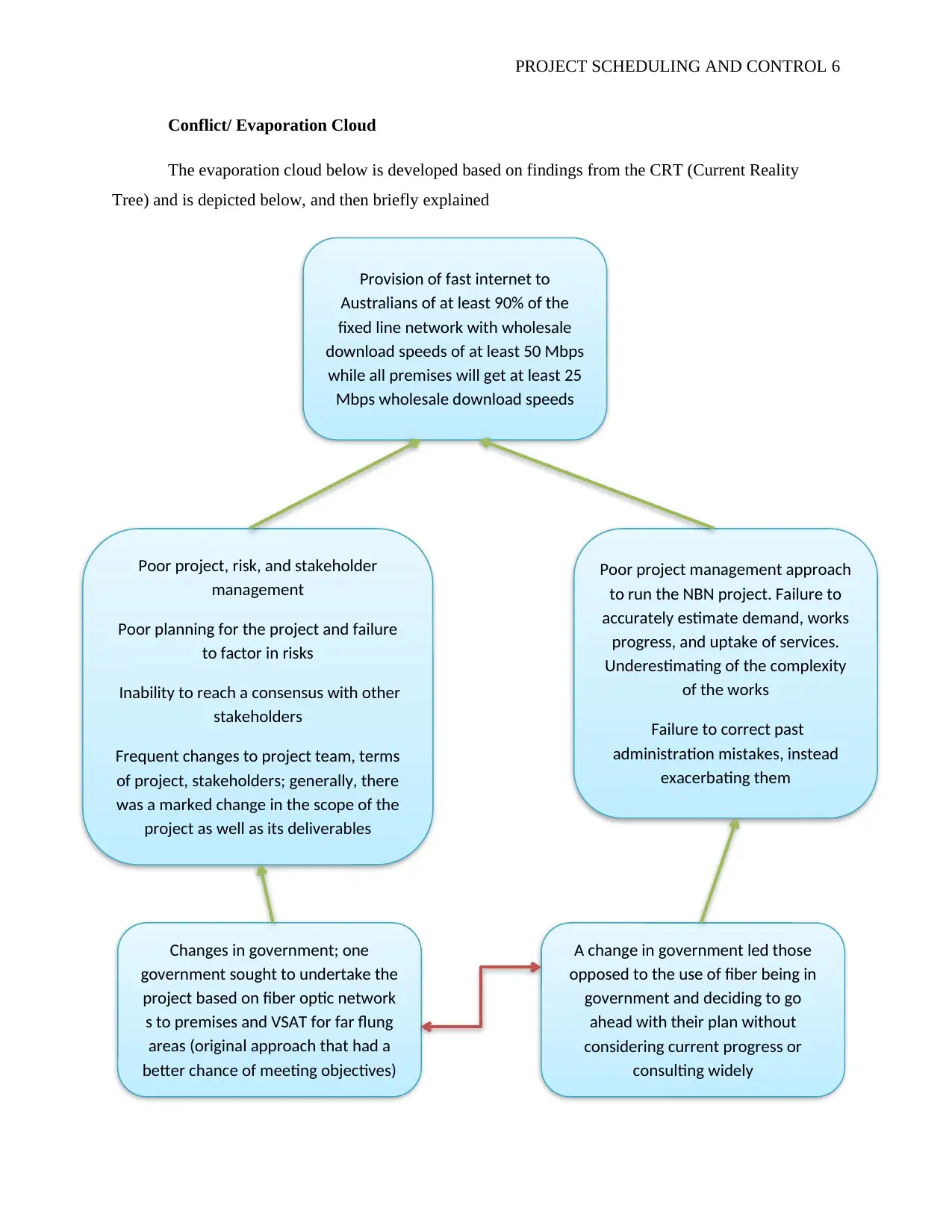
PROJECT SCHEDULING AND CONTROL 6
Conflict/ Evaporation Cloud
The evaporation cloud below is developed based on findings from the CRT (Current Reality
Tree) and is depicted below, and then briefly explained
Provision of fast internet to
Australians of at least 90% of the
fixed line network with wholesale
download speeds of at least 50 Mbps
while all premises will get at least 25
Mbps wholesale download speeds
Changes in government; one
government sought to undertake the
project based on fiber optic network
s to premises and VSAT for far flung
areas (original approach that had a
better chance of meeting objectives)
A change in government led those
opposed to the use of fiber being in
government and deciding to go
ahead with their plan without
considering current progress or
consulting widely
Poor project, risk, and stakeholder
management
Poor planning for the project and failure
to factor in risks
Inability to reach a consensus with other
stakeholders
Frequent changes to project team, terms
of project, stakeholders; generally, there
was a marked change in the scope of the
project as well as its deliverables
Poor project management approach
to run the NBN project. Failure to
accurately estimate demand, works
progress, and uptake of services.
Underestimating of the complexity
of the works
Failure to correct past
administration mistakes, instead
exacerbating them
Conflict/ Evaporation Cloud
The evaporation cloud below is developed based on findings from the CRT (Current Reality
Tree) and is depicted below, and then briefly explained
Provision of fast internet to
Australians of at least 90% of the
fixed line network with wholesale
download speeds of at least 50 Mbps
while all premises will get at least 25
Mbps wholesale download speeds
Changes in government; one
government sought to undertake the
project based on fiber optic network
s to premises and VSAT for far flung
areas (original approach that had a
better chance of meeting objectives)
A change in government led those
opposed to the use of fiber being in
government and deciding to go
ahead with their plan without
considering current progress or
consulting widely
Poor project, risk, and stakeholder
management
Poor planning for the project and failure
to factor in risks
Inability to reach a consensus with other
stakeholders
Frequent changes to project team, terms
of project, stakeholders; generally, there
was a marked change in the scope of the
project as well as its deliverables
Poor project management approach
to run the NBN project. Failure to
accurately estimate demand, works
progress, and uptake of services.
Underestimating of the complexity
of the works
Failure to correct past
administration mistakes, instead
exacerbating them
⊘ This is a preview!⊘
Do you want full access?
Subscribe today to unlock all pages.

Trusted by 1+ million students worldwide
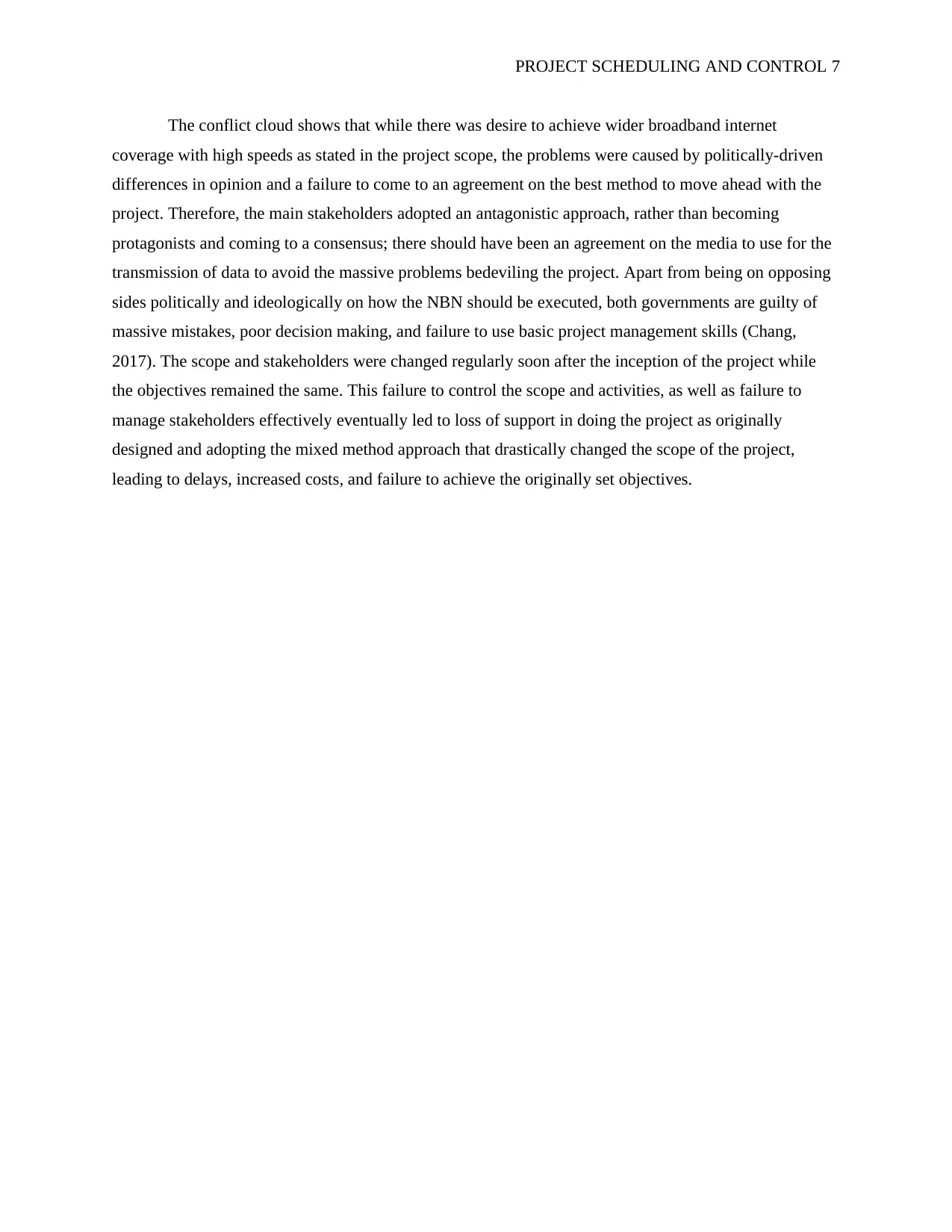
PROJECT SCHEDULING AND CONTROL 7
The conflict cloud shows that while there was desire to achieve wider broadband internet
coverage with high speeds as stated in the project scope, the problems were caused by politically-driven
differences in opinion and a failure to come to an agreement on the best method to move ahead with the
project. Therefore, the main stakeholders adopted an antagonistic approach, rather than becoming
protagonists and coming to a consensus; there should have been an agreement on the media to use for the
transmission of data to avoid the massive problems bedeviling the project. Apart from being on opposing
sides politically and ideologically on how the NBN should be executed, both governments are guilty of
massive mistakes, poor decision making, and failure to use basic project management skills (Chang,
2017). The scope and stakeholders were changed regularly soon after the inception of the project while
the objectives remained the same. This failure to control the scope and activities, as well as failure to
manage stakeholders effectively eventually led to loss of support in doing the project as originally
designed and adopting the mixed method approach that drastically changed the scope of the project,
leading to delays, increased costs, and failure to achieve the originally set objectives.
The conflict cloud shows that while there was desire to achieve wider broadband internet
coverage with high speeds as stated in the project scope, the problems were caused by politically-driven
differences in opinion and a failure to come to an agreement on the best method to move ahead with the
project. Therefore, the main stakeholders adopted an antagonistic approach, rather than becoming
protagonists and coming to a consensus; there should have been an agreement on the media to use for the
transmission of data to avoid the massive problems bedeviling the project. Apart from being on opposing
sides politically and ideologically on how the NBN should be executed, both governments are guilty of
massive mistakes, poor decision making, and failure to use basic project management skills (Chang,
2017). The scope and stakeholders were changed regularly soon after the inception of the project while
the objectives remained the same. This failure to control the scope and activities, as well as failure to
manage stakeholders effectively eventually led to loss of support in doing the project as originally
designed and adopting the mixed method approach that drastically changed the scope of the project,
leading to delays, increased costs, and failure to achieve the originally set objectives.
Paraphrase This Document
Need a fresh take? Get an instant paraphrase of this document with our AI Paraphraser
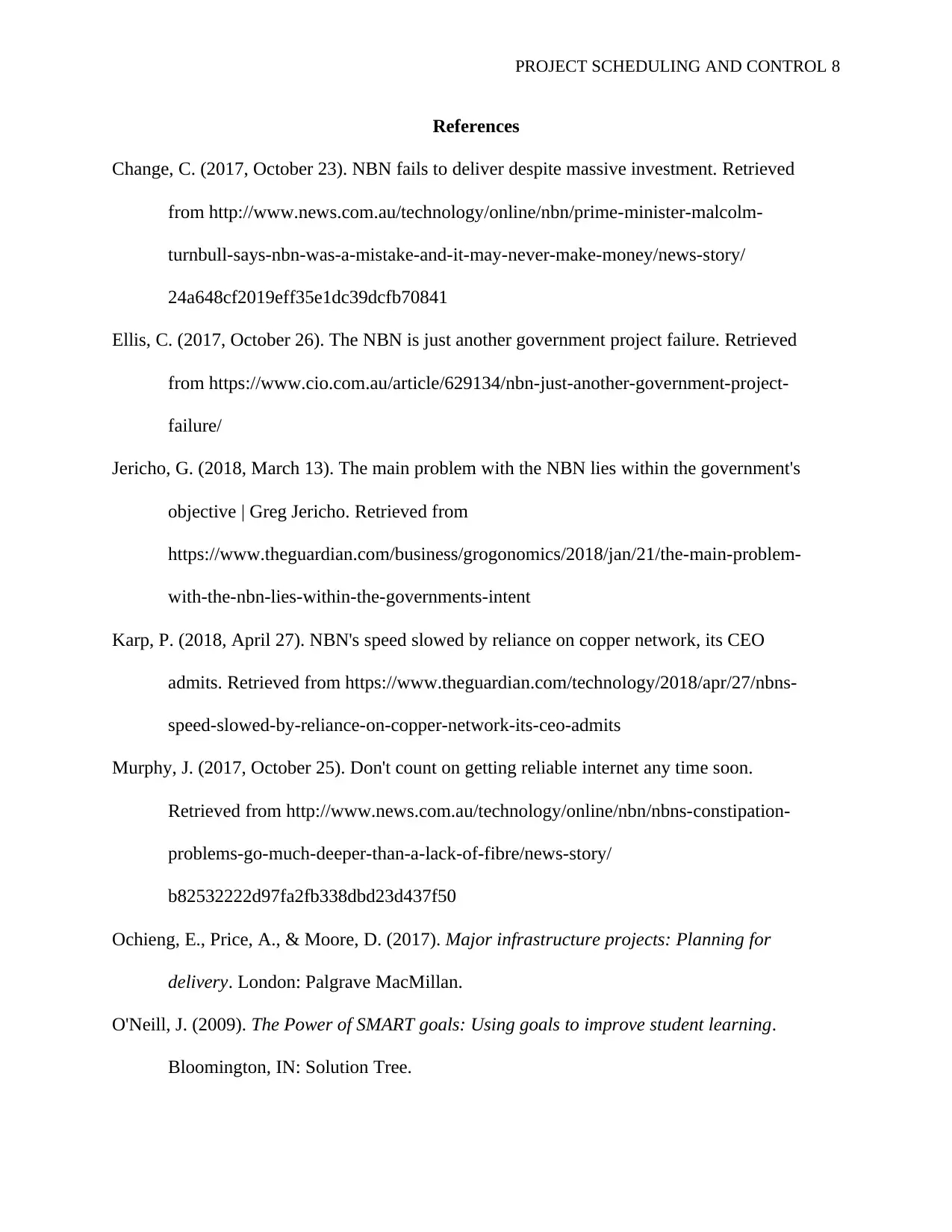
PROJECT SCHEDULING AND CONTROL 8
References
Change, C. (2017, October 23). NBN fails to deliver despite massive investment. Retrieved
from http://www.news.com.au/technology/online/nbn/prime-minister-malcolm-
turnbull-says-nbn-was-a-mistake-and-it-may-never-make-money/news-story/
24a648cf2019eff35e1dc39dcfb70841
Ellis, C. (2017, October 26). The NBN is just another government project failure. Retrieved
from https://www.cio.com.au/article/629134/nbn-just-another-government-project-
failure/
Jericho, G. (2018, March 13). The main problem with the NBN lies within the government's
objective | Greg Jericho. Retrieved from
https://www.theguardian.com/business/grogonomics/2018/jan/21/the-main-problem-
with-the-nbn-lies-within-the-governments-intent
Karp, P. (2018, April 27). NBN's speed slowed by reliance on copper network, its CEO
admits. Retrieved from https://www.theguardian.com/technology/2018/apr/27/nbns-
speed-slowed-by-reliance-on-copper-network-its-ceo-admits
Murphy, J. (2017, October 25). Don't count on getting reliable internet any time soon.
Retrieved from http://www.news.com.au/technology/online/nbn/nbns-constipation-
problems-go-much-deeper-than-a-lack-of-fibre/news-story/
b82532222d97fa2fb338dbd23d437f50
Ochieng, E., Price, A., & Moore, D. (2017). Major infrastructure projects: Planning for
delivery. London: Palgrave MacMillan.
O'Neill, J. (2009). The Power of SMART goals: Using goals to improve student learning.
Bloomington, IN: Solution Tree.
References
Change, C. (2017, October 23). NBN fails to deliver despite massive investment. Retrieved
from http://www.news.com.au/technology/online/nbn/prime-minister-malcolm-
turnbull-says-nbn-was-a-mistake-and-it-may-never-make-money/news-story/
24a648cf2019eff35e1dc39dcfb70841
Ellis, C. (2017, October 26). The NBN is just another government project failure. Retrieved
from https://www.cio.com.au/article/629134/nbn-just-another-government-project-
failure/
Jericho, G. (2018, March 13). The main problem with the NBN lies within the government's
objective | Greg Jericho. Retrieved from
https://www.theguardian.com/business/grogonomics/2018/jan/21/the-main-problem-
with-the-nbn-lies-within-the-governments-intent
Karp, P. (2018, April 27). NBN's speed slowed by reliance on copper network, its CEO
admits. Retrieved from https://www.theguardian.com/technology/2018/apr/27/nbns-
speed-slowed-by-reliance-on-copper-network-its-ceo-admits
Murphy, J. (2017, October 25). Don't count on getting reliable internet any time soon.
Retrieved from http://www.news.com.au/technology/online/nbn/nbns-constipation-
problems-go-much-deeper-than-a-lack-of-fibre/news-story/
b82532222d97fa2fb338dbd23d437f50
Ochieng, E., Price, A., & Moore, D. (2017). Major infrastructure projects: Planning for
delivery. London: Palgrave MacMillan.
O'Neill, J. (2009). The Power of SMART goals: Using goals to improve student learning.
Bloomington, IN: Solution Tree.

PROJECT SCHEDULING AND CONTROL 9
Sibillin, A. (2011). NBN running behind schedule. Retrieved from
http://www.afr.com/technology/enterprise-it/nbn-running-behind-schedule-
20110804-i4f22
Sibillin, A. (2011). NBN running behind schedule. Retrieved from
http://www.afr.com/technology/enterprise-it/nbn-running-behind-schedule-
20110804-i4f22
⊘ This is a preview!⊘
Do you want full access?
Subscribe today to unlock all pages.

Trusted by 1+ million students worldwide
1 out of 9
Your All-in-One AI-Powered Toolkit for Academic Success.
+13062052269
info@desklib.com
Available 24*7 on WhatsApp / Email
![[object Object]](/_next/static/media/star-bottom.7253800d.svg)
Unlock your academic potential
Copyright © 2020–2025 A2Z Services. All Rights Reserved. Developed and managed by ZUCOL.

